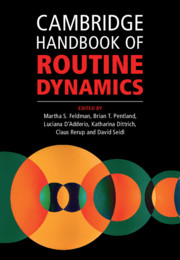Book contents
- Cambridge Handbook of Routine Dynamics
- Cambridge Handbook of Routine Dynamics
- Copyright page
- Contents
- Figures
- Tables
- Contributors
- Preface
- Chapter 1 What Is Routine Dynamics?
- Part I Theoretical Resources for Routine Dynamics Research
- Part II Methodological Issues in Routine Dynamics Research
- Part III Themes in Routine Dynamics Research
- Part IV Related Communities of Thought
- Chapter 33 Carnegie School Experiential Learning and Routine Dynamics
- Chapter 34 Dynamic Capabilities and Routine Dynamics
- Chapter 35 Strategy as Practice and Routine Dynamics
- Chapter 36 Path Dependence and Routine Dynamics
- Chapter 37 Business Process Management and Routine Dynamics
- Author Index
- Subject Index
- References
Chapter 37 - Business Process Management and Routine Dynamics
from Part IV - Related Communities of Thought
Published online by Cambridge University Press: 11 December 2021
- Cambridge Handbook of Routine Dynamics
- Cambridge Handbook of Routine Dynamics
- Copyright page
- Contents
- Figures
- Tables
- Contributors
- Preface
- Chapter 1 What Is Routine Dynamics?
- Part I Theoretical Resources for Routine Dynamics Research
- Part II Methodological Issues in Routine Dynamics Research
- Part III Themes in Routine Dynamics Research
- Part IV Related Communities of Thought
- Chapter 33 Carnegie School Experiential Learning and Routine Dynamics
- Chapter 34 Dynamic Capabilities and Routine Dynamics
- Chapter 35 Strategy as Practice and Routine Dynamics
- Chapter 36 Path Dependence and Routine Dynamics
- Chapter 37 Business Process Management and Routine Dynamics
- Author Index
- Subject Index
- References
Summary
Routine dynamics and Business Process Management (BPM) are two academic disciplines that investigate sequences of action for carrying out work in organizations. Even though they share this phenomenon of interest, there are fundamental differences that separate both research areas. In this chapter, we take a first step to overcome this divide. To do this, we portray BPM by use of the business process lifecycle. The lifecycle well adopted instrument that allows us to describe how activities in BPM are interlinked and discuss the state of the art. Based on these insights, we develop multiple directions how routine dynamics and BPM can learn from and contribute to one another. We believe that a closer integration of both research areas can help to advance how we study and theorize about processes in organizations.
- Type
- Chapter
- Information
- Cambridge Handbook of Routine Dynamics , pp. 513 - 524Publisher: Cambridge University PressPrint publication year: 2021
References
- 8
- Cited by



